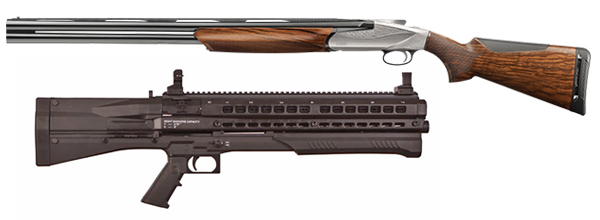16 versus 20


In recent years there’s been a resurgence in popularity of 16 gauge shotguns. It’s tough to say exactly how much impact it has had on bird hunting and shotgunning markets. But maybe the bigger question is why?
We set out at our local sporting clays course one recent morning to solve the mysteries of the 16. Our core group of four shooters outfitted with matching Franchi Instinct SL shotguns in both 16 and 20 gauge were ready to burn through cases of Kent Ultimate Fast Lead. For this test we selected hunting loads — 1 oz of #7½ shot in 2¾” shells — since we’re testing the chops of these in gauges for hunting applications.
But in truth, 16 gauge shells in target loads just don’t exist. A closer look at the shell situation gets even more perplexing. Surfing five big box online retailers, for every one type of 16 gauge shell offered there were 10 times the number of 20 gauge shells, and 40 varieties of 12 gauge. Online retailers averaged just four different flavors of 16 gauge shells, compared to 40 boxes of 20 gauge shell.
The other odd feature of 16 gauge shells is that with few exceptions the loads are nearly identical to 20 gauge — one ounce of shot in 2¾” shells. Even though the diameter of the 16 gauge shell is .67”, larger than the 20 gauge at .615” — shells are loaded with the exact same amount of shot. In the case of these #7½ there are approximately 350 pellets per hull. With the Kent Fast Lead the 20 gauge carry a bit faster pace 1255 fps instead of the published 1220 fps for the 16.

A busy sporting clays course on a weekend is a great way to increase sampling size. When prompted with free shells, free targets and new shotguns, volunteers were easy to find. We ended up with 20 testers of all shapes, sizes and experience levels. The highlight of guest shooters were the Toledo Swamp Rats youth clays team practicing for an upcoming match. Surveying all of our testers, only five had previously shot a 16 gauge while all had previously shot 20 gauge.
None of our shooters noted any difference between gauges in the ability to break clays — as you would expect since both were delivering the same loads. From one sporting clays station each tester fired a series from the gauge of their choice, then alternated gauges and repeated the cycle. Though the 16 gauge Franchi is a few ounces heavier, it was nearly impossible for shooters to distinguish the two guns in hand. So this test really did come down to gauge preference.
Out of 20 shooters just three preferred the 16 gauge. The most frequent reasons cited were recoil and muzzle jump. Nearly everyone perceived a bit more kick from the 16 gauge. Many of the more experienced clay shooters noted it was easier to get back on target faster for the second shot with the 20 gauge.
There are certainly more shotguns we can test as additional manufactures seem bought into this 16 resurgence. Our methods could be more scientific and controlled, but the results seem fairly decisive from our tiny trial. If you choose to shoot a 16 gauge it’s not because of performance. There’s nothing that a 16 can do that a 20 can’t do equally well besides send you on a longer scavenger hunt for shells.








“There’s nothing that a 16 can do that a 20 can’t do equally well besides send you on a longer scavenger hunt for shells” Except for launching a larger payload at the same velocity with hardly any increase in recoil. The actual numbers are so close in recoil as to virtually be the same. The slight increase in impulse energy is nullified by the slight increase in weight. Oh and patterning – which you did not test – for upland uses the 16 beats the pants off 20 with every choke we tested, and with several factory loads. But other then that you are correct…..and then this ” With the Kent Fast Lead the 20 gauge carry a bit faster pace 1255 fps instead of the published 1220 fps for the 16″. Well we ran a chrono on this and it turns out the 20 was running 1215 on average, the 16 1228 on average. Another reason to NEVER believe the “published” (ie you read it on the box) information. Just saying.
Odd — there’s no indication of where all this testing of yours occurred, Michael. Happy to look over your article if you include a link.
I’ll just go ahead and stand by our real world testing of hunting scenarios with real shooters on moving targets, because patterning a shotgun from a bench with a chrono shares very little with how shotguns are actually used afield.
Good luck with your search for 16 shells. Best save up.
The extra recoil of the 16 gauge could be psychological as they know it’s bigger than a 20 gauge so expect more kick although the load is the same.16, plus 10 and 28 gauges,still struggle on which is good as variety is the spice of life.After the 12 then 20 or .410 must be the most popular shotgun size although there a pretty big chasm between them and 12 gauge sales.
You said the 20 and the 16 had the same number of shot. I do believe that 1oz of 7.5 not matter what they were loaded in (12,16,20) would be the same number. I maybe mistake but I believe that to be true. In real world hunting most would use 11/8 for the 16.
And most would likely use 3″ 20 gauge shells which would thereby contain more shot — 1-1/4 ounce and a denser pattern — than your proposed 16 gauge loads. All of this hypothetical at this point. Good luck finding any 16 gauge shells without hateful pricing.
16 gauge ? I stay away from all the hype from target clay competitions… I’ll stay out of the hype and stay put with the 16 for hunting…. Besides,… I load my own shells for my double w /mod. and imp. cylinder.. Will switch to steel or nickel plated shot for tighter patterns…
If you load your own shells, it can certainly make the 16 more tolerable. But buying shells off the shelf is making the 16 go the way of the dinosaur.